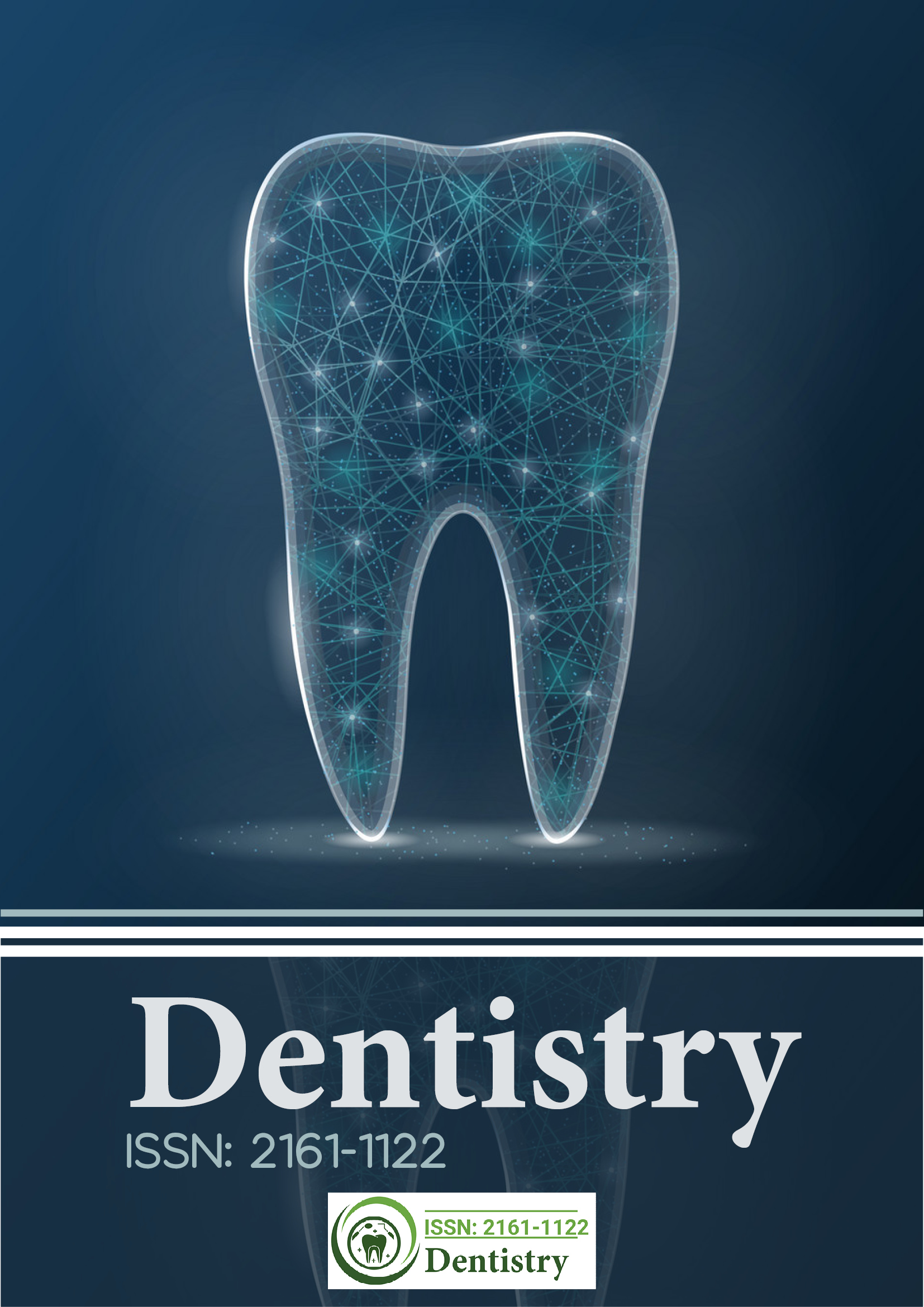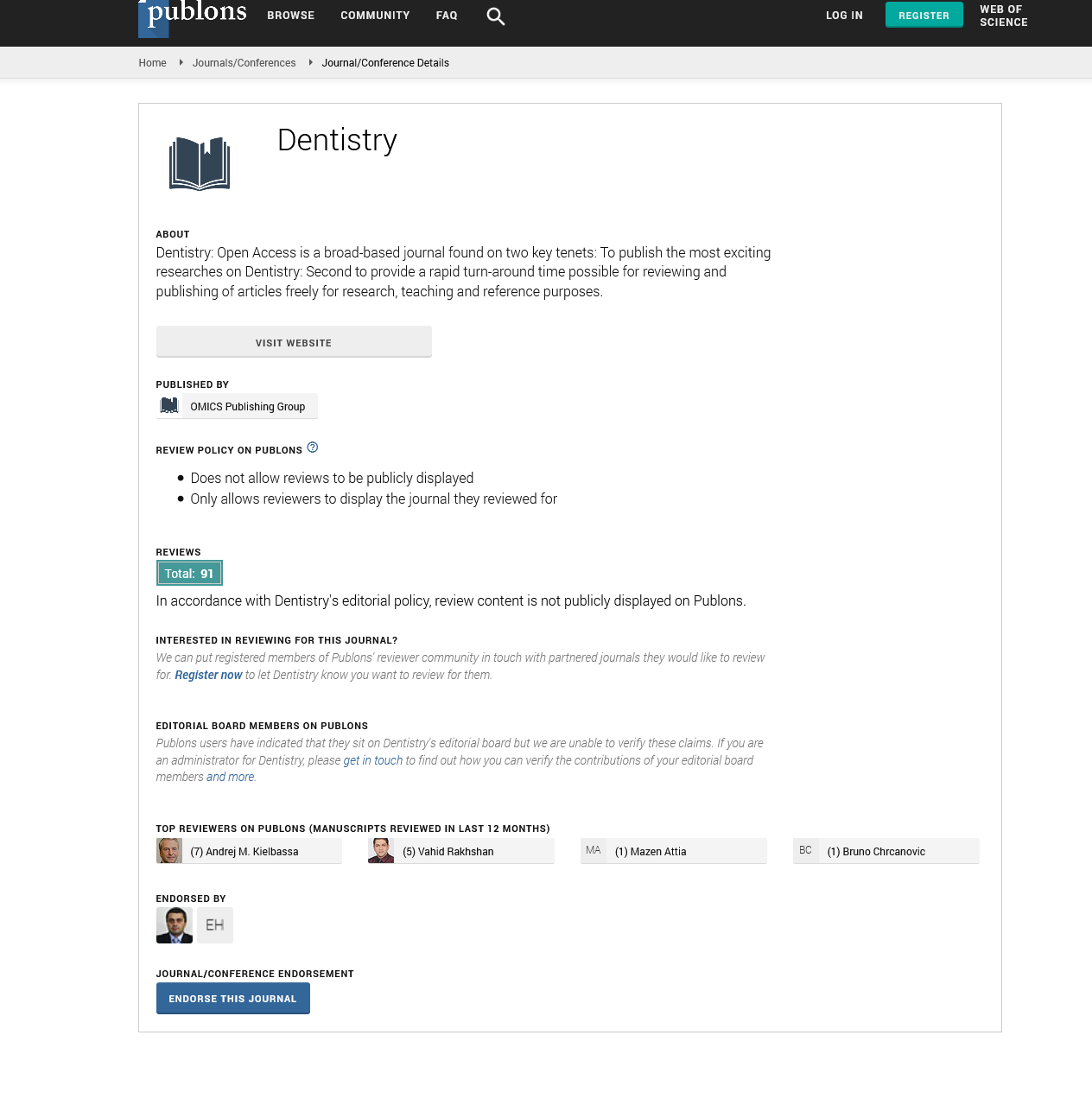Citations : 2345
Dentistry received 2345 citations as per Google Scholar report
Indexed In
- Genamics JournalSeek
- JournalTOCs
- CiteFactor
- Ulrich's Periodicals Directory
- RefSeek
- Hamdard University
- EBSCO A-Z
- Directory of Abstract Indexing for Journals
- OCLC- WorldCat
- Publons
- Geneva Foundation for Medical Education and Research
- Euro Pub
- Google Scholar
Useful Links
Share This Page
Journal Flyer

Open Access Journals
- Agri and Aquaculture
- Biochemistry
- Bioinformatics & Systems Biology
- Business & Management
- Chemistry
- Clinical Sciences
- Engineering
- Food & Nutrition
- General Science
- Genetics & Molecular Biology
- Immunology & Microbiology
- Medical Sciences
- Neuroscience & Psychology
- Nursing & Health Care
- Pharmaceutical Sciences
Perspective - (2024) Volume 14, Issue 2
Understanding the Objectives, Processes, and Rehabilitation of Tooth Extractions
Miri Minato*Received: 03-Jun-2024, Manuscript No. DCR-24-26158; Editor assigned: 05-Jun-2024, Pre QC No. DCR-24-26158 (PQ); Reviewed: 19-Jun-2024, QC No. DCR-24-26158; Revised: 26-Jun-2024, Manuscript No. DCR-24-26158 (R); Published: 03-Jul-2024, DOI: 10.35248/2161-1122.23.14.688
Description
Teeth removal, or tooth extraction, is a common dental procedure performed for a variety of reasons. While it is often a last resort after other treatments have been considered, it remains a key aspect of dental care. It explores into the reasons for tooth extraction, the different types of extractions, the procedure itself, and post-operative care. One of the primary reasons is severe tooth decay. When a cavity is left untreated, it can penetrate deep into the tooth, reaching the pulp and causing an infection. If the infection is extensive and cannot be treated with a root canal or antibiotics, extraction may be necessary to prevent the spread of infection. Gum disease, another common dental issue, can also lead to tooth extraction. Periodontal disease damages the bones and tissues that hold teeth in place. In advanced stages, it can cause the teeth to become loose. In such cases, extraction might be the best option to maintain overall oral health.
In preparation for orthodontic treatments such as braces, teeth might need to be removed to create space for proper alignment. This is particularly common in cases where the patient’s jaw is not large enough to accommodate all the teeth. Impacted teeth, particularly wisdom teeth, are frequently extracted. Wisdom teeth, or third molars, often do not have enough room to emerge properly and can become trapped in the jawbone or gums, causing pain, swelling, and potential infection. Teeth may also need to be extracted as a result of pain. Accidents or injuries can cause teeth to become severely damaged. If a tooth is broken beyond repair, extraction might be the only viable solution.
The two types of tooth extractions that are commonly used are simple and surgical. Teeth that are visible within the mouth are extracted simply. Usually, these operations are carried out under local anesthesia. After the tooth is loose, the dentist removes it with forceps using a stand. Surgical extractions are more complex and are performed when a tooth is not easily accessible. This might be the case with impacted teeth or teeth that have broken off at the gum line. Surgical extractions often require an incision in the gum and may involve removing some bone around the tooth. These procedures are typically done under local anesthesia with sedation or general anesthesia, depending on the complexity of the case and the patient’s level of anxiety.
Before the extraction, a thorough examination and consultation are necessary. This includes reviewing the patient’s medical history and taking X-rays to understand the position and condition of the tooth and surrounding bone. Based on this assessment, the dentist or oral surgeon will decide on the best approach for the extraction. For a simple extraction, the area around the tooth is numbed with a local anesthetic. The dentist then uses an elevator to loosen the tooth from the periodontal ligament fibers and alveolar bone. Once the tooth is sufficiently loosened, it is removed with forceps. The procedure is usually quick, and the patient might feel pressure but not pain. In the case of a surgical extraction, the process is more involved. The oral surgeon makes a gum incision to access the tooth after giving anesthesia. If necessary, bone surrounding the tooth is removed, and the tooth might be divided into sections for easier removal. Once the tooth is extracted, the incision is closed with stitches, and a gauze pad is placed over the extraction site to control bleeding.
Immediately after the extraction, it is important to bite down on the gauze pad to control bleeding and help a blood clot form in the socket. This clot is essential for healing, and patients should avoid activities that might dislodge it, such as vigorous rinsing, spitting, or drinking through a straw. Pain and swelling are common after an extraction. The dentist may also prescribe stronger pain medication if needed. Swelling typically peaks within 48 hours and then gradually subsides. Maintaining oral hygiene is important, but patients should be careful around the extraction site. Gentle rinsing with salt water can help keep the area clean without disturbing the clot. Brushing and flossing should be continued, but caution should be exercised to avoid the extraction site.
Citation: Minato M (2024) Understanding the Objectives, Processes, and Rehabilitation of Tooth Extractions. J Dentistry. 14:688.
Copyright: © 2024 Minato M. This is an open access article distributed under the terms of the Creative Commons Attribution License, which permits unrestricted use, distribution, and reproduction in any medium, provided the original author and source are credited.

